Dec. 22 and Dec. 25 Coming Sooner than You Think
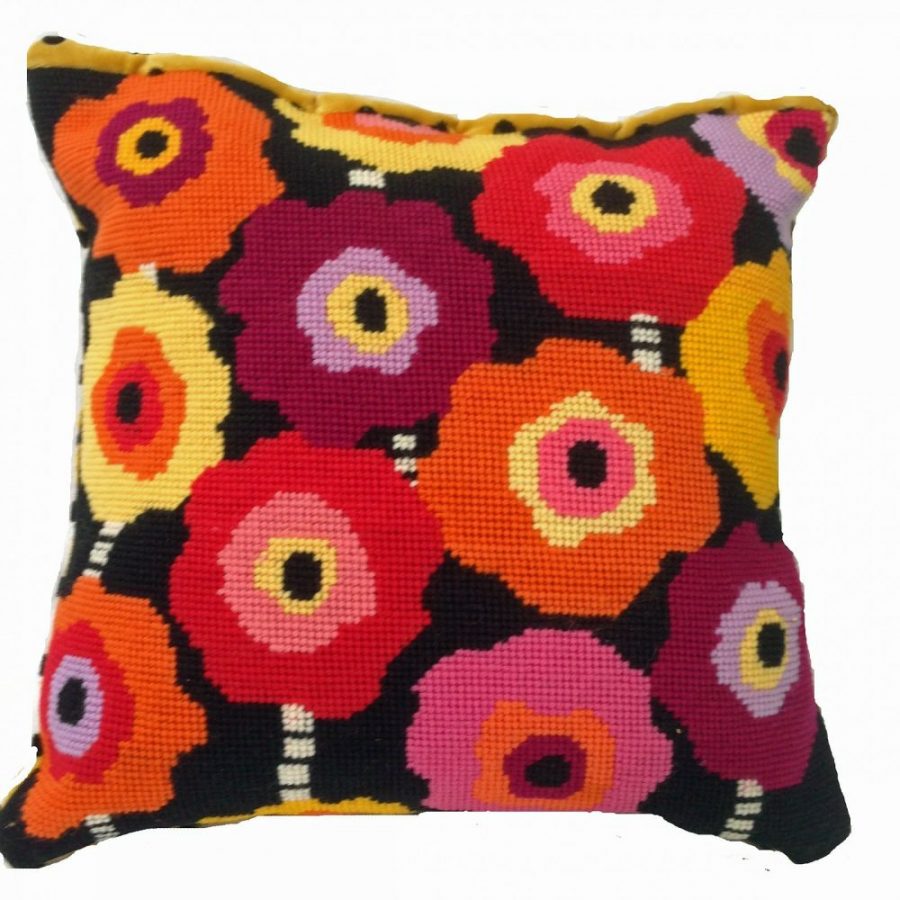
By Linda Lee
I don’t remember doing embroidery. But I have the proof that I did: One very bad sampler done, I’m sure, under my grandmother’s tutelage.
Clearly, I did not grow up to be a crafter. If you, however, are the type to knit a baby blanket, cross stitch a pillow, crochet a shawl or embroider something clever for a holiday present, you might as well start now.
We are here to help you find fun, interesting projects with flower themes for that someone in your life who loves flowers.
You came to Flower Power Daily, didn’t you? If you want cats, go somewhere else.
Moreover, if you, like me, procrastinate, there are a few projects here that can be done in a day or, hard to believe, in two or three hours. (There is even a cheat, which I will get to shortly.)
They say that embroidery is the new thing. (Remember when it was knitting?) Well. there are 87,000 stitchers on the Reddit r/embroidery page, and they now have their own wiki, to answer basic questions. When I checked on a Saturday afternoon there were more than 100 people on the page. That’s traffic.
It’s Reddit, so expect some rude patterns. But there is also stunning embroidery. And a lot of avocados.
Embroidery
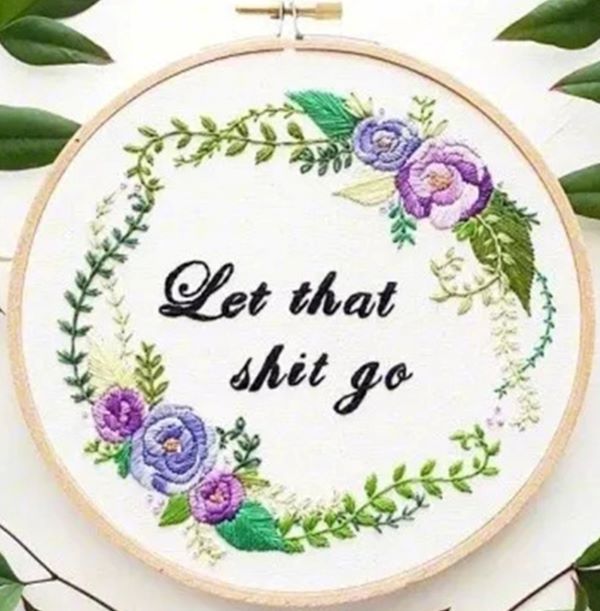
Long gone are the days when embroidery and piano were taught to increase digital dexterity. That was done so young men and ladies would have a beautiful “hand,” which is to say beautiful “handwriting.” Today, no one can even read script.
But the rediscovery of embroidery has been explosive. For some it was a way to stop smoking (or drinking). Something to do while they watch television. They can embroider while they chat, which they can’t do while they count cross stitch, a solitary occupation. (If you don’t know, don’t even ask.)
Besides, embroidery can be creative. Once you learn a few stitches, you can start writing your own sentiments.
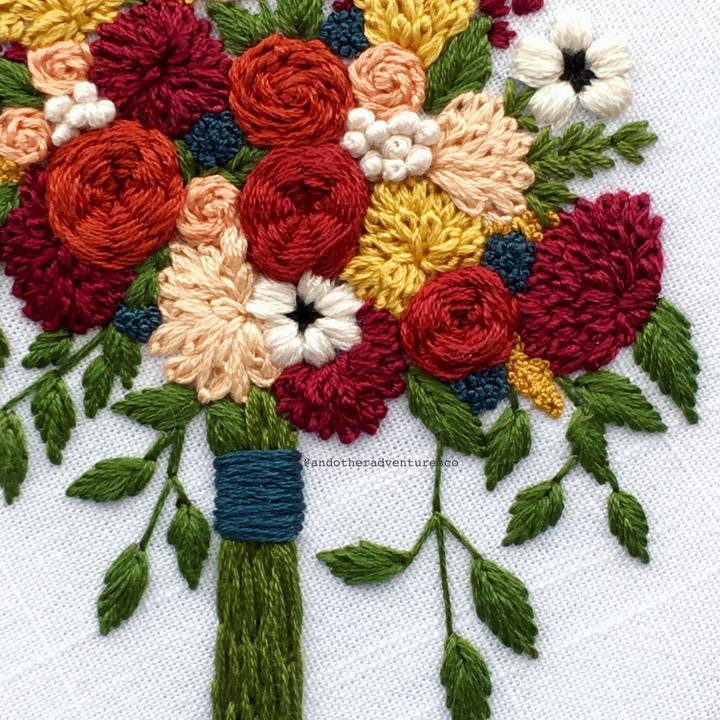
Sure you can use a pattern, like this bouquet, above, from and other adventures, which comes as a kit including materials for $38. (They sell an entire Bloom series, including one bouquet in black, beige and white, and rank their projects by skill level.)
Or, if you prefer, there is this from the always interesting Etsy, a downloadable pattern for advanced embroiderers: a stained glass window with a flower theme, $7.
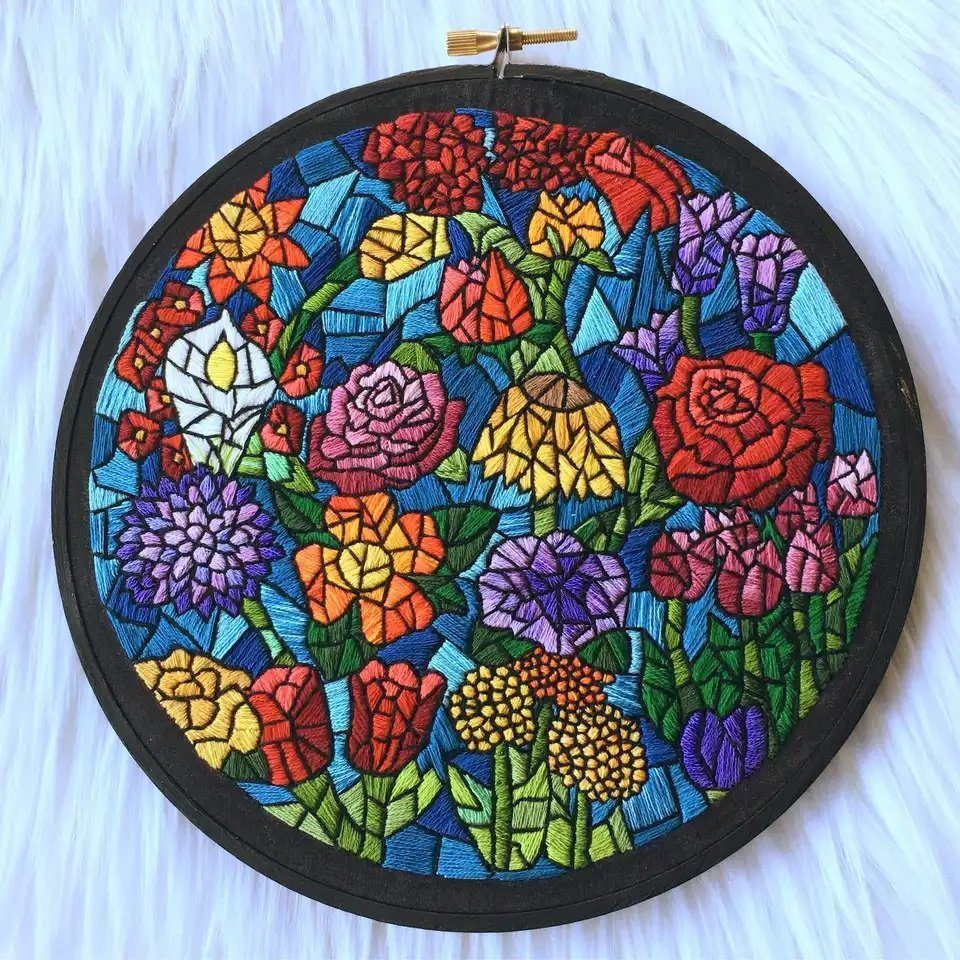
Dang pretty. That would make a nice holiday present, if you could force yourself to give it up.
And then there is this stunner, from T. Burr. You can see that this is a step upward in subtlety and sophistication. The gradation of colors is painterly. This is art. But it’s not crewel embroidery, folks. Because it’s using silk thread not wool thread. You know that, right?
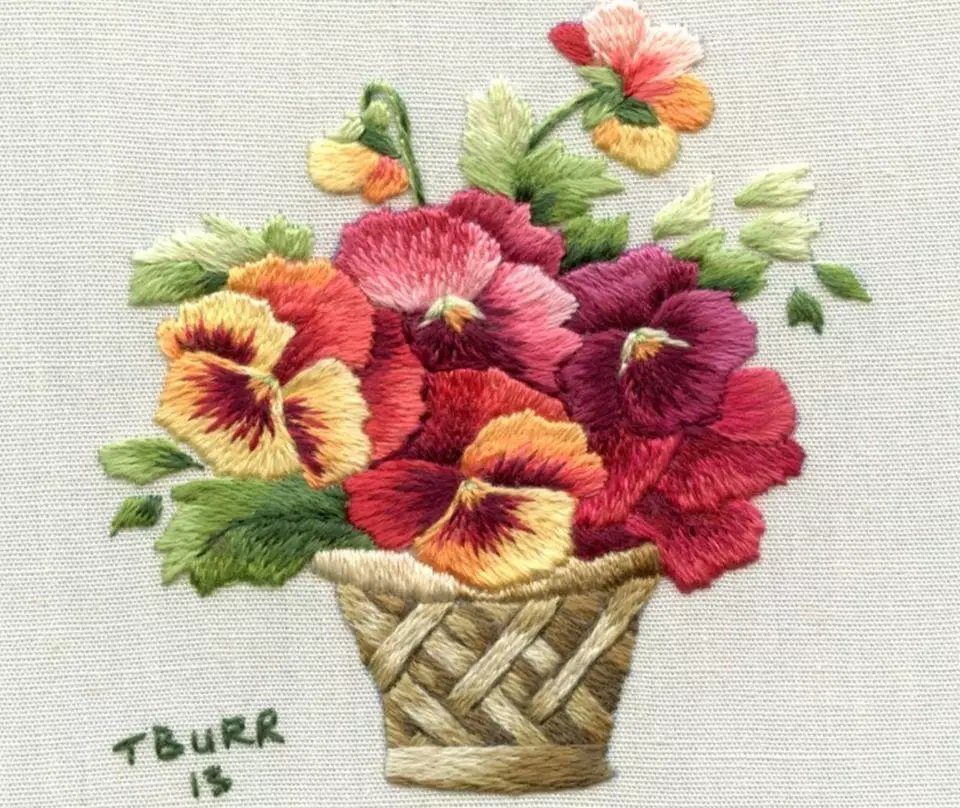
T. Burr is Trish B embroidery , a place where you can order patterns like the above, kits, needles, thread, books. She is based in South Africa, but knows how to send things to you. You can also watch videos, which can be repetitive, like this one on shading a silk pansy petal, part of embroidering flowers. (Turn off the music, which is annoying.) She calls what she does “painting,” and I’d go along with that. Patterns like this are for experienced embroiderers. If you have one of those on your holiday gift list, he or she would be knocked out to get a pattern from this web site.
But you can also make up your own pattern. Try this: make tiny stitches, and add a personal message in a certain location: the embroidery becomes like a tattoo. Something for only the person for whom it is intended to see.
Embroidery, you see, is fun. It’s not like knitting, which is tiresome. (Hold on, knitters. I’m getting to you.) It’s dainty. And there are lots of things for beginners. Kits are available on Amazon, often from Asia, that offer inexpensive beginner’s kits. Something like “Let That Shit Go,” which seems remarkably popular, will come with four patterns, a hoop to hold the cloth taut, needles and thread. And, of course instructions. $11.
Then there is this newfangled kind of embroidery called “ribbon” embroidery. This is that wall-hanging, gimmicky, kind of kitschy embroidery. I know, I know. It’s kind of crafty. Some people would not even call it embroidery. And the ability to do it depends on a lot of practice. (It’s like those ads that say “results may vary and and may not reflect the typical purchaser’s experience, and are not intended to represent or guarantee that anyone will achieve the same or similar results.”) Now listen to me. Do not order a cheap kit on Amazon.
Those kits come from Asia. The instructions will be in Chinese. You will not be able to do ribbon embroidery. The ribbon will not be silk. Some ribbons will be missing. Or, if you like a challenge, go right ahead.
Instead, listen to Linda here. First, watch a good video like this one. I think flowers 6 and 9 are works of art, and I wonder how much she had to practice to get all ten, perfectly spaced, into that little hoop. Also, such steady hands, and a great manicure.
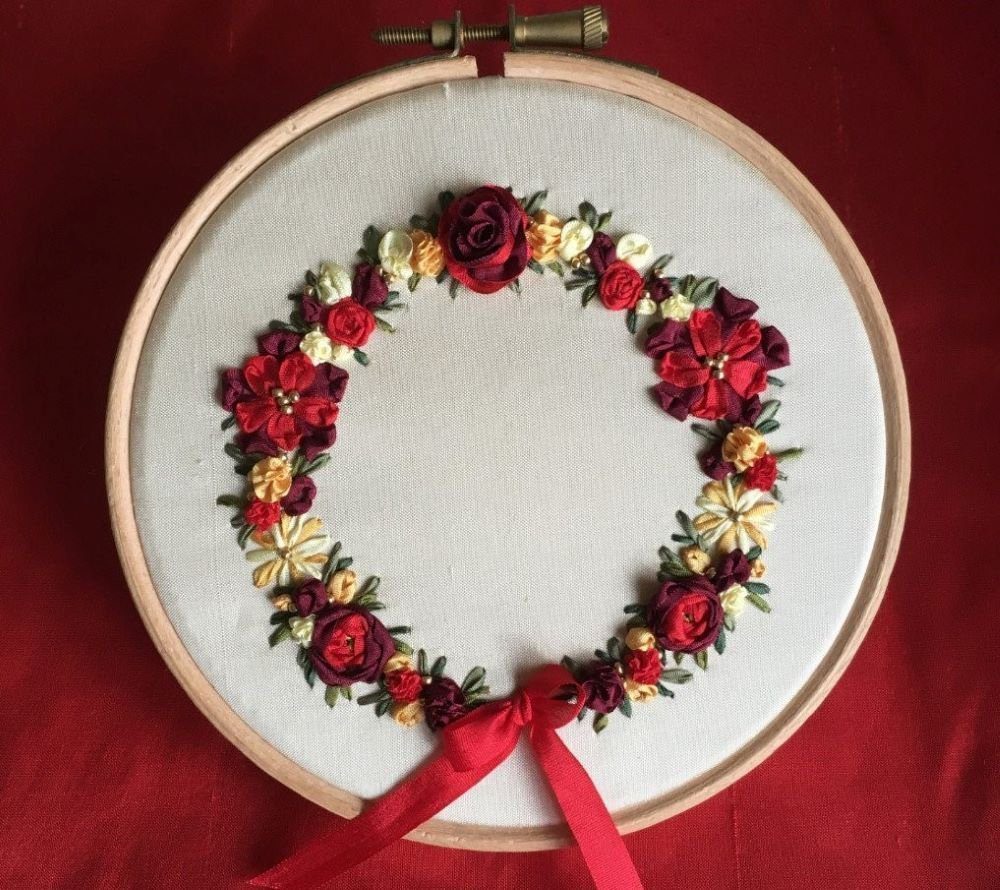
Then order a kit like above, this one. It’s from England, so you know the instructions are going to be in, you know, English. And it is pretty. It’s not, ahem, stumpwork. (That’s the kitschy embroidery where you stuff filler in to make things 3-D, so yuck.) The above is from Laurelin, a site that says, authoritatively, that ribbon embroidery was popular in Victorian times. Laurelin would know. She graduated, with distinction, from the Royal School of Needlework, and worked on Kate Middleton’s wedding gown.
The Laurelin “Christmas Wreath” silk ribbon embroidery kit, $38, includes silk dupioni fabric, embroidery thread, silk ribbons, needles, the design and full instructions. It fits a 6 to 8 inch hoop., which you will need to supply. This is the silk ribbon embroidery you want to do.
And, if you begin doing silk flower embroidery, you will want to know about the South African source for hand-painted silk ribbons that match the subtle shades of actual leaves and petals. That is Di van Niekerk, whose exquisite ribbons in various widths, sell for $2 to $3 for 2 meters, about 7 feet. Colors include pine, silver, and hydrangea.
And, finally, the cheat. There are busy bees, mostly on Etsy, a surprising number from places like Tasmania, who will embroider almost anything to order. At a reasonable price. If your grandmother’s favorite Christmas cactus died over the summer, someone can custom embroider one that will not succumb to spider mites.
All you have to do is ask.
And this source named Lisa has beautiful hand-embroidered botanical art, if you just want to hanging a couple of hoops ($45 each) of house plants. You don’t need to fess up that it isn’t your own work.
Knitting
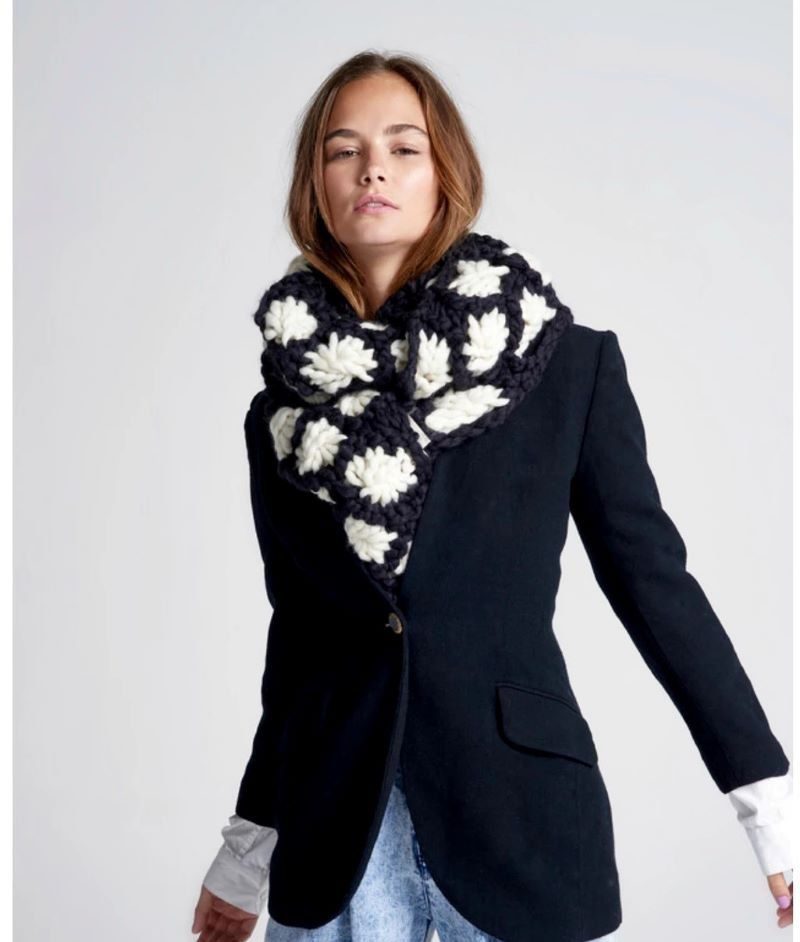
I’m not going to spend a great deal of time on knitting, except to turn you on to a fast way to make a scarf, with dozens of possible color combinations. It’s called Loopy Mango. Remember big needles? Go online at Loopy Mango, and order a kit for knitting a long Aster scarf: choose one color for the outside blocks, maybe “iceberg,” another color for the “asters,” say “bordeaux.” Then follow instructions. There is a video that makes me think I could do it, and I haven’t knit for 40 years. It’s not cheap: $98 for the kit, including the circular needles; $70 without.
But it’s Italian merino wool. The scarf will be eight feet long. And hand-made. The instructions say it should take two to three hours to finish a scarf. I’m planning on giving a kit to my granddaughter, with colors she chooses for her mom. A 10-year-old can’t do much to give her mom on Christmas, a hand-made gift that would actually be nice and surprise her. But this might be it.
Needlepoint
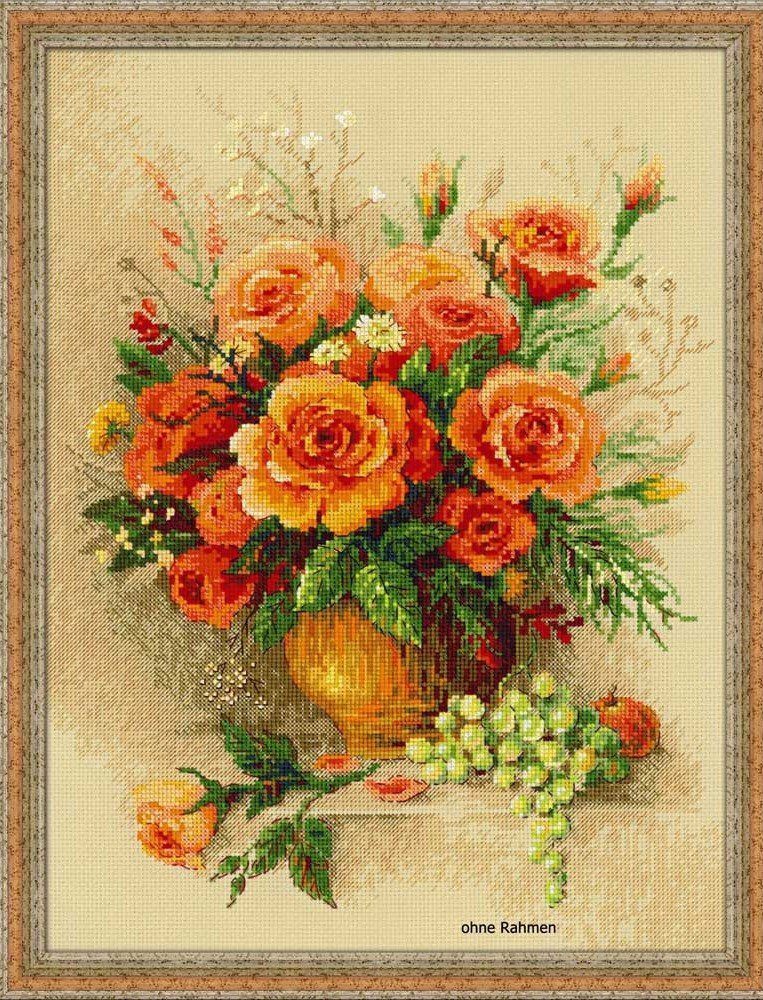
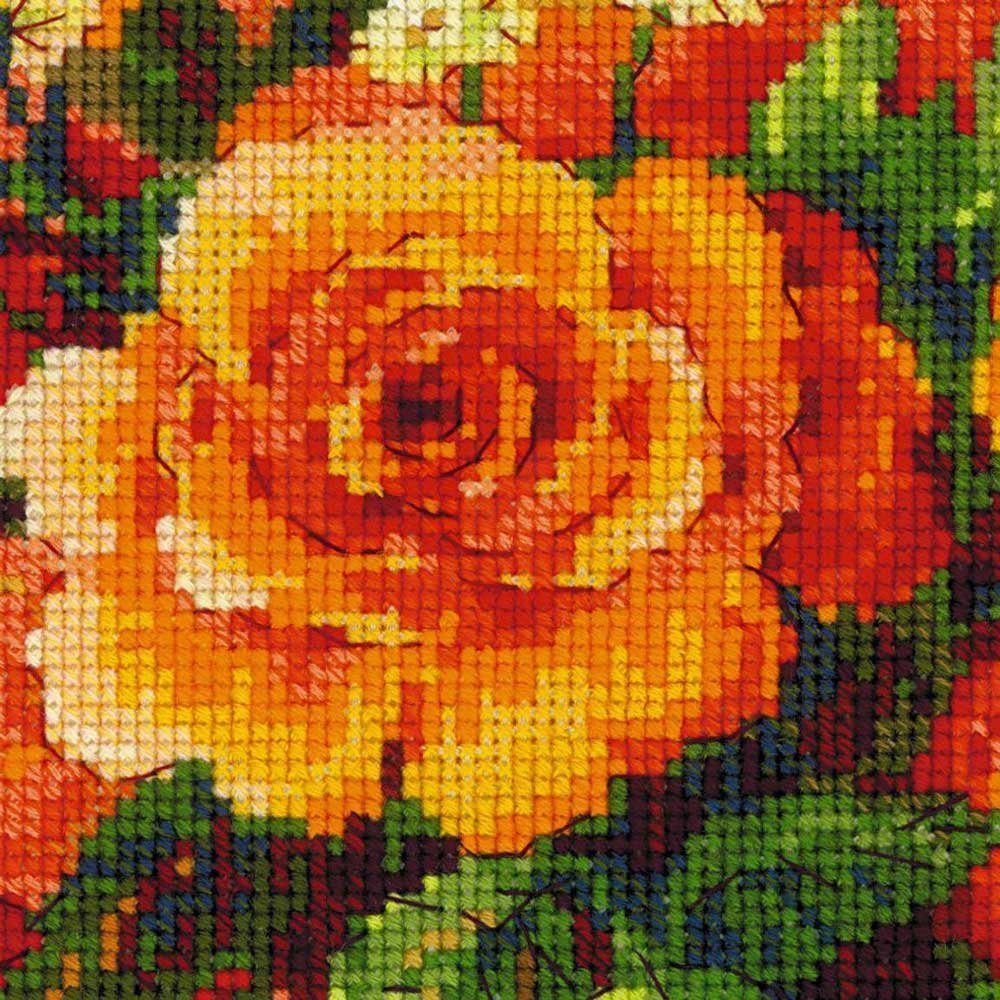
Let’s start with counted cross stitch, which can be a bit like working on a crossword puzzle. True, there are some people who like to ask friends what a five letter word is for lizard (“skink”), but usually crosswords are a solitary occupation.
So too counted cross stitch. Cross stitching means someone is going to make a lot of little x’es on squares. Like pixels. And in the end there will be a picture. Sound boring?
I leave that to you. If you know a cross stitcher, and that person likes flowers, the above is a nice example. I threw in the blow-up of the orange rose so you really could contemplate how many little x’es it will take to do this.
And how long.
So if you want to do a cross stitch for someone for the holidays, get cracking.
This is “Tea Rose” by Riolis, which comes with everything you need, including 26 colors of cotton thread. It comes from Russia. That and the Baltic countries seem to love making these kits. And kids, the best price I can find is on eBay, $45, but it’s a big canvas, around 12 inches wide and around 16 inches tall. Without the frame. Instructions in lots of languages, including English.
Now onward to Judaica:

It never occurred to me that a dreidel might need a cover. Perhaps this is just for a decoration. But here it is, your needlepoint dreidel cover.
It’s from Rishfield, and is $87 on sale. It is hand-painted pomegranates, thus the steep price, which does not include thread.
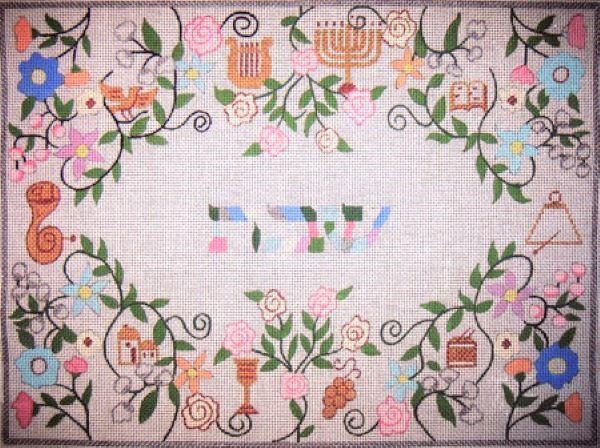
From Magic Needle, this attractive hand-painted, pastel challah cover, which costs $80 or so, and can be ordered from Annie & Company in Manhattan. That’s just for the canvas, of course. You did note the words “hand painted.” As with above, you choose the colors of the thread, that’s where your artistry comes in. You make the piece your own. It is 19 by 14 inches.
Next in the world of hand-painted needlepoint. Pillows. Let’s start with something for beginners.

This is from Australia, and of course you could buy a pillow for less than $125. But that’s not the point, is it? Think of the pride you would have if you gave it to someone saying, “I made this for you.” The poppy pillow kit, from Needlepoint for Fun, includes everything you need except the frame. Shipping from Australia to the U.S. is $8.50.
This next one is considerably more advanced. It is an Elizabeth Bradley needlepoint kid, from England. Elizabeth Bradley has prize-winning booths to show off her needlepoint at the annual RHS Chelsea Flower Show. Her works are highly regarded for their portrayal of hellebores and orchids, pansies and lilies and her company gets top marks for the quality of their kits. The canvas is 20 by 20 inches and the design itself is 16 inches square.
This particular tapestry pattern, Primavera, costs $230 and comes with needles, top-grade wool, and a vast choice of background colors from winter white to sand to duck-egg blue to black. (Warning, monitor colors are misleading. On mine, “winter white” looked pale yellow, and “cream” was a beautiful shade of light pink. I would take Elizabeth Bradley’s word for it.)
Shipping to the U.S. is free, on orders over $200. The stitch used here is called the Victorian cross stitch, and technically, since this is wool, this is crewel work.
Elizabeth Bradley also sells kits for carpets, tapestries, upholstery and more. If you get someone in the family started on this, you may have begun an entire industry.
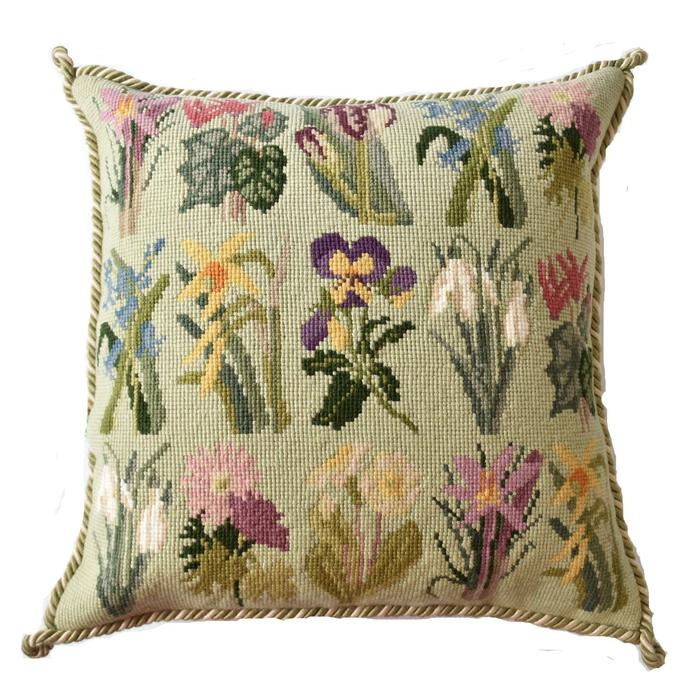
Crochet
I could not finish talking about crafts and the holiday season without mentioning crochet.
Wait. Don’t hang up. I am not talking about crocheted plant holders or afghan blankets.
I am talking about something that might, just might, be kind of pretty. A crocheted shawl with a flower theme. It all depends on the colors chosen. (Isn’t that always the case?)
This one caught my eye.
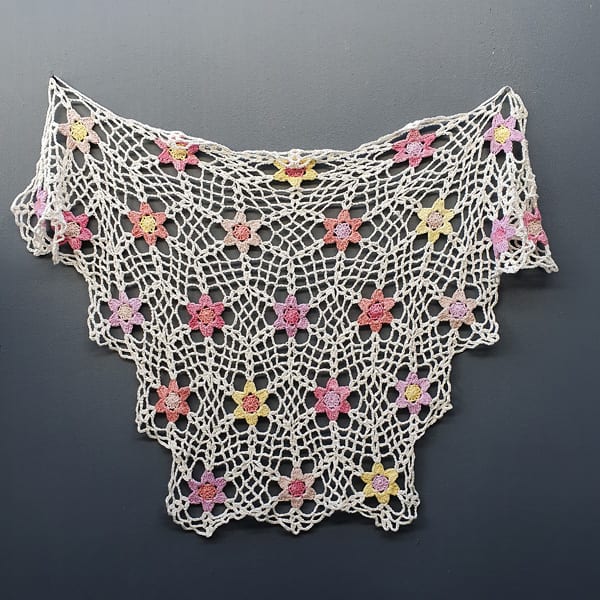
It’s from Nurturing Fibres, a company in South Africa that gives away the patterns, then sells you their beautiful, natural, hand-dyed yarns, including organic cotton, bamboo yarn, 100 percent “superwash” Merino, and Kidsilk, their custom blend of 70 percent of kid mohair and 30 percent silk, through their American distributor, Good Loops Yarn. The above shawl, crocheted in Nurturing Fibres’ shades of single-spun “Lace” wool like lunar, conch shell, quince and vanilla, would certainly not be treated like Aunt Ida’s dreaded afghan.
An order of quince yarn ($18.50) would be 678 yards, but weigh only 3.53 ounces. The whole shawl would be gossamer.
This should give you a good, early start on your holiday crafts and shopping season. Don’t blame us if you look at this on December 23, and suddenly realize you need the Loopy Mango knitting kit.
Too bad. We were here. Where were you?
Linda Lee was an editor at The New York Times. She was deputy editor of House & Home, where she edited the garden column, and she was a frequent contributor to Sunday Styles.
